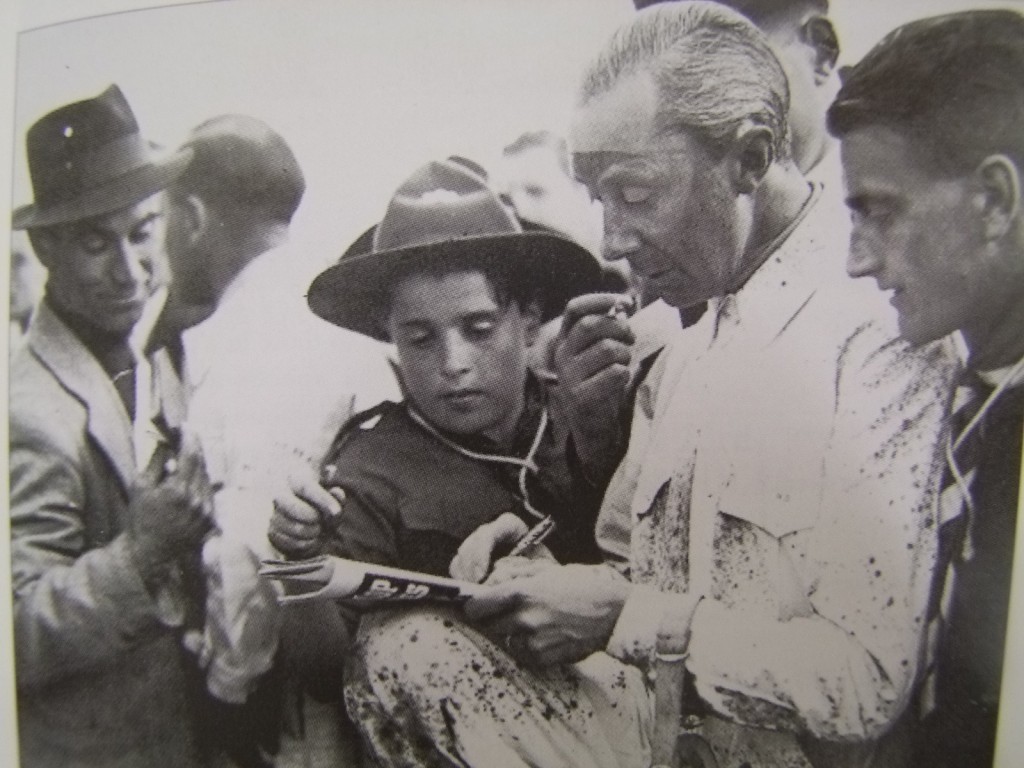
Kieran’s Our City, Our Town Article,
Cork Independent, 19 May 2011
In the Footsteps of St. Finbarre (Part 257)
Thrills and Spills
The Cork Motor Derby of April1938 in all terms was big. The organisers built in a series of aspirations from the sporting side to the event being part of Cork’s economic development, civic boosterism, cultural change and regional interaction with European countries. Newspapers such as the Cork Examiner, Irish Press, Irish Independent and Sunday Independent also carried page spreads of the event. The event was noisy, atmospheric and masses of people wanted to be part of it and wanted something to be proud of.
Thousands of people came out for the practice runs. On Tuesday19 April 1938, a special ship arrived at Cork bringing most of the cross-channel and continental competitors and their cars in time for the weighing in and inspection arrangements. Masses of people stood on Penrose Quay as the Motor Cars were hoisted onto the Cork quays. Some members of the public took pictures of the scenes that were unfolding. The Prince of Siam, B. Bira had his cars packed in special travelling motor vans, which were accompanied by his mechanics.
In addition, Messrs. Henry Ford and Son, Ltd., Cork celebrated their 21st birthday in business in Cork and to mark the occasion an open house was held at the works. The factory opened its doors to the public and many of the visitors to the Motor Derby were encouraged to take the tour of the works and see “the latest methods of car production”.
Excursions were run from all parts of Britain and the young Aer Lingus Teoranta (established on May 22, 1936) arranged for “special air liners” to carry passengers from England to the race course. In addition, a number of private aviation clubs sent “machines” as well as spectators from England. Special excursion tickets at a fare of 21/- were issued from Dublin for the 5pm train on Thursday 20 April and for the 7a.m. and 9.30a.m trains on Friday 21 April. Day trip tickets were also issued on the Friday at a fare of 10/6d from Kingsbridge, Dublin. A special first class train from Dublin was sponsored by the Royal Irish Automobile Club.
Dudley Colley, driving a 1,500cc Frazer Nash that was entered by C.H. Gates of Kildorrey and a member of the Dublin University Motor Cycle and Light Car Club, won the National Motor Handicap. The handicap formed the first of the Irish Derby meeting of the Irish Motor Racing Club at Cork. Colley won by the narrow margin of three seconds. There were a dozen starters, most of them being in vehicles that were long since familiar features at Irish motor races. Seven of the eight, who completed the course of 52 miles, finished within two minutes of the winner. One of those was the only woman competitor Miss Dorothy Stanley Turner. Second and third places went to Dublin entrants D. Yule (driving a C.M.Y. Special and Charlie W. Manders (driving an Adler), respectively.
For many years, Dudley Colley had been a well known performer in motor competitions in the Dublin area, but it was not until the Phoenix Park race of 1937 that he entered a long distance event. In that race he came 8th (with the same car he drove in the Cork race). The car he was driving in Cork was made by Frazer Nash Ltd. (after its founder Archibald Goodman Frazer-Nash) who came into being In December 1922 and initially produced a sports car before in time making BMWs.
The collective newspapers argue that seventy thousand spectators saw lap records beaten several times during the International Light Car Race and Cork Grand Prix on Saturday, 23 April 1938. Prince Birabongse of Siam or B. Bira, driving an E.R.A. and Rene Dreyfus in a Delahaye, were the respective winners. Both victories were comfortably gained, the winners taking the lead in the second lap in each race and never being passed. B. Bira won the Light Car Race at an average speed of 91.35m.p.h. He broke the lap record three times in succession, his best speed being 95.71m.p.h.
The Grand Prix field was reduced to eight. The winner Rene Dreyfus averaged 92.m.p.h. and also broke the lap record three times, his best being 95.71 m.p.h. Bira was beaten by two minutes and ten seconds in this race, after a great effort chasing Rene Dreyfus. There were also some hair-raising incidents during the day. J.P. Wakefield in a Maseratti had an amazing escape when his car plunged over the banking at hell hole bend in Carrigrohane and fell thirty feet down the slope. He was thrown clear and only sustained bruises and shock. While lying on the ground, B. Bira’s car only missed him by only a foot. In addition, A.C. Dobson had to drive the last three miles of the Light Car Race being sprayed with oil from the gear-box. However, he beat Villoresi, an Italian, by one-fifth of a second for second place.
The prizes were distributed at the Cork Car Race Dance at the Arcadia on the Lower Road. The Lord Mayor of Cork, Cllr James Hickey and Mr. Jack O’Sheehan, Director of Publicity, Irish Hospital’s Trust, made the presentations before almost a crowd of 1,500 people.
to be continued….
Captions:
591a. Rene Dreyfus, winner of the Cork Grand Prix, 1938 (source: W. Fitzsimmons)
591b. Map of Cork International Car Race Course, April 1938 (source: Irish Press, 4 April, 1938, p.9)
